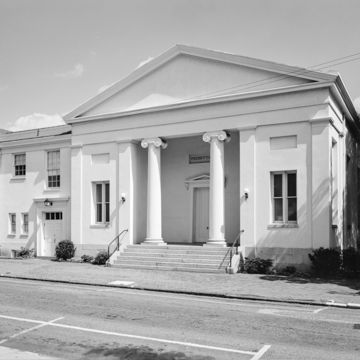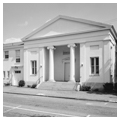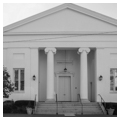The crisp stucco planes and sculptural Ionic capitals of Walter's design are similar to other Presbyterian churches in the region, suggesting that classical styles came to be adopted by the denomination beginning with John Haviland's First Presbyterian Church (1820–1822) on Washington Square in Philadelphia (demolished). Another surviving example is the similar Presbyterian church of 1838 in Princeton, New Jersey, often attributed to Charles Steadman, whose facade elevation was actually also by Thomas Walter. Although Walter was a Baptist, in the first few years of his career Presbyterian churches were a mainstay of his practice, with half-a-dozen commissions for buildings as far west as Louisville, Kentucky. Walter also designed the Federal-style house for Judge Thomas Bell at 101 S. Church Street in 1835.
You are here
First Presbyterian Church
If SAH Archipedia has been useful to you, please consider supporting it.
SAH Archipedia tells the story of the United States through its buildings, landscapes, and cities. This freely available resource empowers the public with authoritative knowledge that deepens their understanding and appreciation of the built environment. But the Society of Architectural Historians, which created SAH Archipedia with University of Virginia Press, needs your support to maintain the high-caliber research, writing, photography, cartography, editing, design, and programming that make SAH Archipedia a trusted online resource available to all who value the history of place, heritage tourism, and learning.





